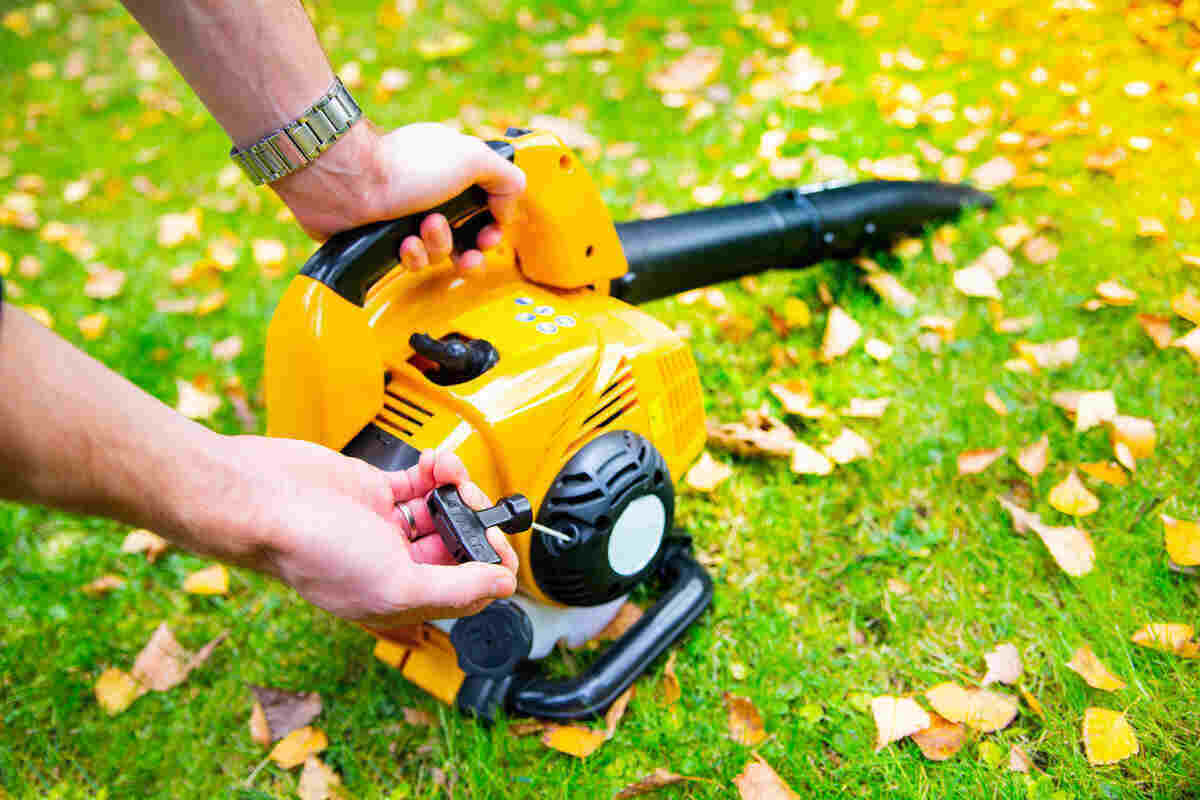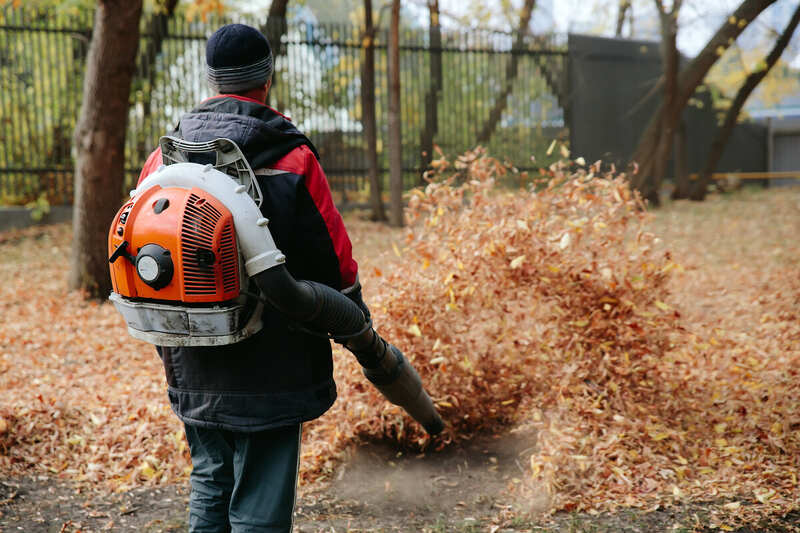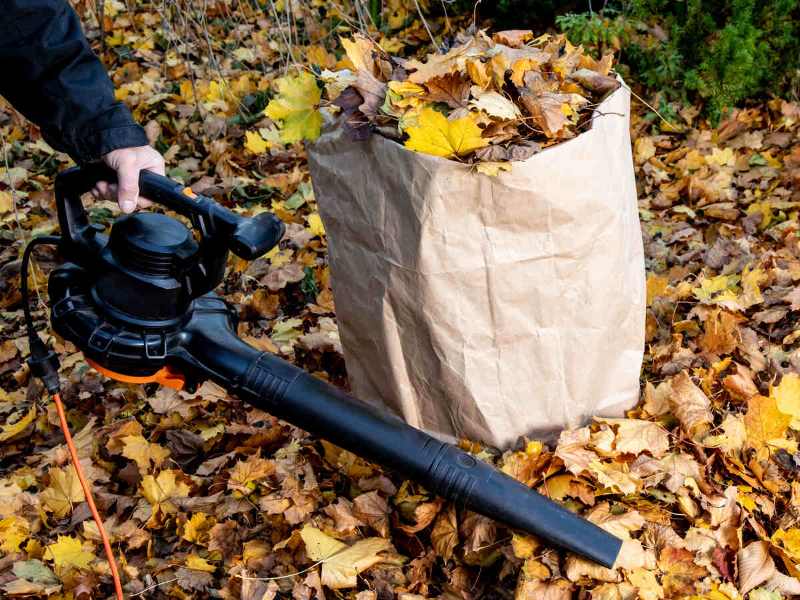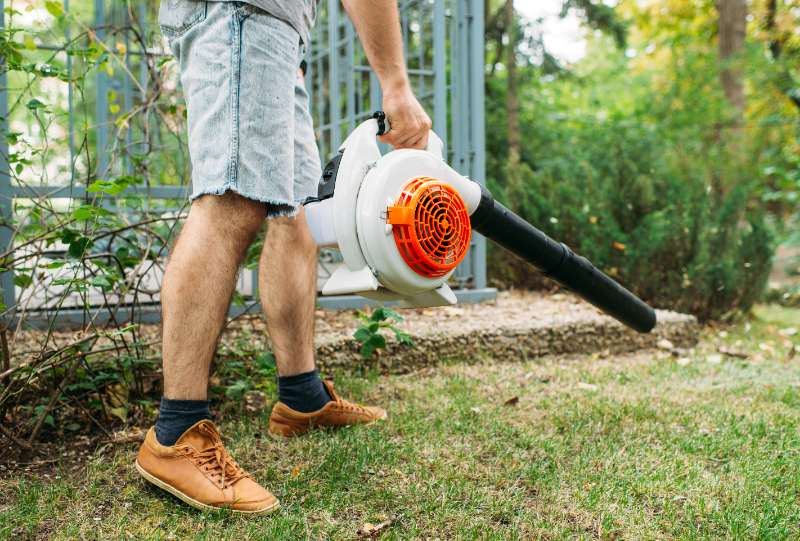
Using the wrong lawn equipment can be a headache, especially when leaves start to fall. We’ll explain how to choose the right leaf blower for you by understanding the various types and power sources.
But if you’re in a hurry to blast the leaves in your yard, use our decision calculator to help you choose the best leaf blower, depending on yard size, leaf coverage, and preferred features.
Choose the Best Leaf Blower For Your Needs
Understand the Different Leaf Blower Types
Using a leaf blower is one of the best ways to clean up leaves. The three main types of blowers are:
- Handheld
- Backpack
- Walk-behind
Each one has its own strengths and drawbacks, so the right leaf blower will depend on your yard size and the amount of leaves to clear.
Romel de Castro, long-time landscaper and lawn care pro, says that choosing the right blower type not only helps get the job done but also helps ensure your body is up for the task.
His advice: “Don’t burden yourself with a backpack blower if you’re just doing quick work in the driveway.”
See Related: How to Use a Leaf Blower
Handheld Leaf Blowers
Designed to be carried in one hand, handheld blowers (pictured above) are the smallest and most lightweight of all leaf blowers. In fact, most models are compact enough to hang in your garage. Plus, they’re easy to maneuver around tight spaces.
Best for: Small to medium yards with light to moderate leaf coverage
Pros:
- Budget-friendly
- Lightweight and portable
- Compact design for easy storage
Cons:
- Can be tiring to carry for extended use
- Not powerful enough for heavy or wet leaf piles
- Limited runtime compared to backpack and walk-behind blowers
Estimated cost: Corded electric handheld models cost as low as $20 to $30, while cordless leaf blowers can cost up to $300.
| If you change your mind about doing the leaf cleanup yourself, hire a LawnStarter leaf removal pro instead. With a customer rating of 4.3 stars and nearly 12,000 completed jobs last year, our pros make leaf removal effortless for around $158. |
Backpack Leaf Blowers

Worn like a hiking pack, backpack leaf blowers have padded straps and a powerful motor. The design distributes the weight evenly, making it easier to handle.
Best for: Medium to large yards with lots of deciduous trees or heavy leaf fall
Pros:
- More powerful than handheld blowers
- Great for larger yards and professional use
- Comfortable to use for extended periods with less strain
Cons:
- More expensive upfront
- Heavier and bulkier than handhelds
- Loud noise, often requiring ear protection
Estimated cost: Entry-level backpack blowers typically start around $160, with many models priced between $250 and $400.
Walk-Behind Leaf Blowers
Mounted on wheels and pushed like a mower, this is the most powerful leaf blower for your heavy-duty leaf blowing needs. Forget about finesse — a walk-behind leaf blower is more about raw power. Its big engines and wide nozzles help clear huge piles of leaves quickly.
Best for: Large yards where speed and power matter most
Pros:
- Clears leaves fast
- Extremely powerful
- Can be used for commercial use
- Requires little physical effort to operate
Cons:
- Expensive compared to other blowers
- Bulky and takes up a lot of storage space
- Hard to maneuver in small yards or tight spaces
Estimated cost: At around $975 to over $1,200, a walk-behind leaf blower is the most expensive leaf blower type.
Understand the Different Leaf Blower Power Sources
Whether gas, electric corded, or battery-powered, your chosen power source will affect convenience, cost, and performance.
Gas-Powered Leaf Blowers
De Castro shares that a gas-powered blower is his top choice, as it gives maximum power due to its two-stroke or four-stroke engine. It’s the strongest leaf blower for heavy-duty work, but its roar can wake up an entire neighborhood.
Best for: Large properties with lots of deciduous trees and heavy leaf piles
Pros:
- Available in all blower types
- No cord limits, completely mobile
- Most powerful option for tackling big jobs
Cons:
- Produces emissions, not eco-friendly
- High noise levels (80 decibels and up)
- High-maintenance; needs fuel mixing and cleaning
Estimated Cost: The average cost of a gas leaf blower is around $390.
Electric Corded Leaf Blowers

Since electric corded blowers get their power directly from an electric outlet, you get steady power without worrying about refilling gas or recharging batteries. They’re lightweight and simple to use, making them a popular choice for homeowners.
Best for: Small to medium-sized yards, provided your extension cord is long enough
Pros:
- Lightweight and easy to carry
- More affordable than gas or battery models
- Low maintenance with no fuel mixing or charging
Cons:
- Impractical for large yards
- Difficult to maneuver around trees or obstacles
- Limited reach, which depends on the extension cord length
Estimated Cost: On average, the best electric leaf blowers cost around $90.
Battery-Powered Leaf Blowers

With a battery-powered leaf blower, you won’t have to worry about cords or fuel. Since it runs on rechargeable lithium-ion batteries, it’s lighter and quieter than gas models. But it’s lacking in power and run time. To extend its runtime, you can use a spare battery.
Best for: Small to medium yards where noise is a concern
Pros:
- No emissions
- Low-maintenance
- Portable and easy to use
- Quietest option, great for noise-sensitive areas
Cons:
- Replacement batteries can be expensive
- Less powerful than gas or high-end corded models
- Requires constant charging (a single charge usually lasts around 20 to 60 minutes)
Estimated Cost: The best cordless leaf blowers cost around $275.
Key Performance Specifications
When narrowing down your options, keep these specifications in mind as they make a big difference in your leaf blower performance.
| Power – air speed (mph) and air volume (CFM) | Leaf blowers with high miles per hour (mph) ratings have faster airspeed for wet leaves. Leaf blowers with high cubic feet per minute (CFM) ratings have more blowing capacity for large leaf volumes. |
| Weight and ergonomics | For handheld and backpack blowers, look for features like ergonomic handles and padded straps. |
| Noise | Gas models are the loudest, battery blowers are the quietest, and corded electric blowers fall somewhere in between. |
| Variable speed control | Some blowers let you adjust airflow on the fly — perfect for switching between big piles and around flower beds. |
| Nozzle shape | Flat nozzles sweep leaves neatly, while round ones help break up stubborn, stuck debris. |
| Vacuum/mulching capabilities | Certain leaf blower vacuums can suck up leaves and shred them into fine bits you can use as mulch or add to your compost. |
Pro Tip: Lawn care professionals like de Castro typically use leaf blowers with 500+ CFM and 200+ mph. But homeowners dealing with mostly dry leaves can use models with 150-500 CFM and 110-190 mph.
FAQ on Choosing a Leaf Blower
Yes, leaf blowers can damage plants or landscaping. The strong airflow may harm delicate flowers or scatter mulch, so use a lower setting when removing leaves from flower beds, mulch, and other sensitive areas.
Corded electric blowers are the easiest to maintain and require minimal cleaning.
You can have your leaf blower repaired at authorized service centers or small engine repair shops. To avoid voiding the warranty, check your owner’s manual first.
Choose Your Leaf Blower with Confidence
Matching the leaf blower to your needs will make fall cleanup a whole lot easier. But if you’d rather skip the noise and hassle, you can always hire a LawnStarter leaf removal expert to do the work. During fall, you might also want to hire a LawnStarter lawn mowing pro to cut your grass and help manage the leaves in your yard.
Sources:
- “Climate Change at Monmouth.” Monmouth University.
- “Leaf Blower Best Practices – What & Why.” Seattle Department of Construction & Inspections.
- Romel de Castro, landscaper and lawn care pro. Personal interview.
- “Safe Operating Procedures.” The University of Memphis.
Main Image: Handheld leaf blower. Image Credit: Shutterstock